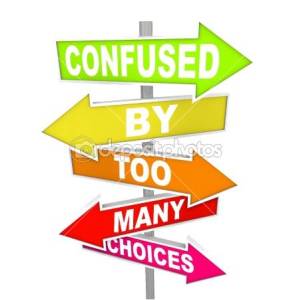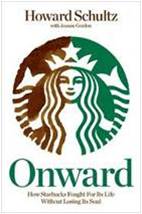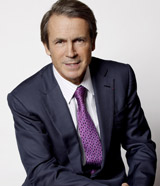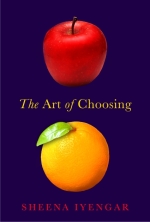 In a magazine interview, Catherine Zeta-Jones, the Welsh actress and wife of Michael Douglas, describes one of her daily chores, which involve making choices.
In a magazine interview, Catherine Zeta-Jones, the Welsh actress and wife of Michael Douglas, describes one of her daily chores, which involve making choices.
“It is,” she said, “deciding whether to buy that beautiful little dress she had found while shopping in California, knowing full well that the shoes you need to go with it were in one of your homes in the Caribbean or Europe.”
Pity the rich and famous!
We have more choices today than we have ever had in history and yet making countless decisions each day may be a burden rather than a pleasure. In this excellent book, which brings in scientific research and personal examples, Dr. Sheena Iyengar, Professor at Columbia University, describes just why some of these choices are so difficult.
Key words
Psychology, cognitive psychology, behavioral economics, business, marketing, strategy.
Summary
Never in time have humans had so much choice. A grocery store in the US today contains more than ten times as many choices as it did 50 years ago.
“The typical supermarket, which carried 3,750 different items in 1949, now boasts some 45,000 items. Walmart and other “big-box” retailers “offer” smorgasbords of over 100,000 products to Americans.”
Any first time visitor to the US is usually astounded by the number of questions that a waiter will ask you when choosing your meal. However, all this choice doesn’t necessarily make us happy.
Indeed, being given a huge amount of choice in a short space of time can actually be quite difficult to handle. A survey in 2007 shows that 20% of Germans in Berlin would like to see the Wall put back up.
There is even a new word in the German language: Ostalgie (a portmanteau of Ost (east) and Nostalgie (nostalgia.)
Jam: when less is more
Dr. Iyengar’s best known experiment is the one with jam. If you’re not familiar with this, it involved giving people the choice of either 6 or 24 jams, and allowing them to try them. Though more people stopped to try the jam when there were 24, only 3% went on to buy them. When 6 jams were offered, fewer people stopped; however, 30% of the people went on to buy the jams on offer, and a far greater number than the ones who had tried the 24. We have today more choice than we have ever had in the past. To some extent, this is cultural. Dr. Iyengar considers that Americans desire personal choice in four times as many domains as Japanese cultures do, for example.
The Magical Number Seven
Following on to Miller’s 1956 seminal paper, “The Magical Number Seven, Plus or Minus Two,” Iyengar considers that we can only deal with a limited amount of choice. When we get too much choice, we get overwhelmed and then we tend not to choose at all. This has been proved in numerous experiments, from buying insurance, retirement plans, to the famous jam experiment we’ve just described.
Procter & Gamble, for example, having studied this experiment, reduced its varieties of Head & Shoulder shampoo, from 26 to 15, and saw sales increase by 10%.
The consulting group, McKinsey, thought the experiment to be so serious that they introduced the 3 by 3 rule, which means that clients first choose from 3 choices, which then lead to another 3 choices, which then lead to another 3 choices.
The essence of Dr. Iyengar’s argument is that having so many choices requires that we give up far more than we gain. This has a psychological cost, and by increasing the number of choices, we thereby increase the cost. Since there are so many possible outcomes from this, this becomes increasingly difficult to deal with.
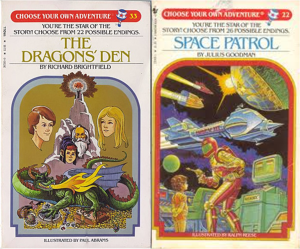
Choose Your Own Adventure books teach children how to face the problem of choosing but leave us asking the question: “What if…?”
Choose your own Adventure
As Iyengar points out in the epilogue of her book, all of us who had read the Choose Your Own Adventure books as a child knew that part of the thrill of going through the narrative was to be able to cheat a little bit. You could pick from 3 options of the story, and occasionally take a quick look to see the consequences before making the choice, hoping that you didn’t end up getting eaten by the dragon. In our daily lives of course, we don’t have such luck.
Indeed, it is not just a question of looking forward. As adults we cannot help speculating of on lives of we had made different decisions. “What if I had studied German rather than Spanish? What if I had accepted an offer to a different university?”
In real life though we can’t go to the start of the book and work out the consequences of changes one or two options in out lives. Here is the inherent problem with having too many choices. We know that certain options may never come again, so the psychological pain of giving them up may be very high indeed. It may well be that the fewer choices you have, the happier you might become.
So, perhaps the next time you are in a restaurant, ask your friends to choose your meal for you. You’ll be laughing from the starter right through to your dessert.
Sheena Iyengar talks about her book
Interesting quotes from the book:
When we speak of choice, what we mean is the ability to exercise control over ourselves and our environment. In order to choose, we must first perceive that control is possible.
The ability to choose well is arguably the most powerful tool for controlling our environment.
Although a CEO’s shouldering of responsibility for his company’s profit is certainly stressful, it turns out that his assistant’s responsibility for, say, collating an endless number of memos is even more stressful. The less control people had over their work, the higher their blood pressure during work hours.
What affected people’s health most in these studies wasn’t the actual level of control that people had in their jobs, but the amount of control they perceived themselves as having.
The Japanese saying makeru ga kachi (literally “to lose is to win”) expresses the idea that getting one’s way is less desirable than maintaining peace and harmony.
A common view of freedom is that it means “freedom from the political, economic, and spiritual shackles that have bound men. In contrast to this “freedom from,” Fromm identifies an alternate sense of freedom as an ability: the “freedom to” attain certain outcomes and realize our full potential.
United States had a 2008 per capita GDP of $47,000 compared to the $33,400 average of the European Union. Out of the 133 countries for which the Gini coefficient is measured, Sweden has the most equitable distribution of wealth. The United States is ninety-fourth, right below Cameroon and the Ivory Coast.
No longer do young adults embark upon a long-term career, get married, and have children shortly after completing their education. Instead, the years from about 18 to 25 are now characterized by the search for identity.
The “marshmallow studies,” conducted in the late 1960s by renowned psychologist Walter Mischel, are widely known today for their exploration of how we resist- or give in to- temptation. The trials and tribulations of the four-year-old participants didn’t last long: On average, the children waited only three minutes before ringing the bell.
We tend to have a better memory for things that excite out senses. You might overestimate the number of times your colleague wore a red tie, or underestimate how often he wore a gray one, simply because red is a brighter color.
“Intuition is nothing more and nothing less than recognition.” Herbert Simon
Achieving a world-class expert-level understanding of a single domain, it takes an average of 10,000 hours of practice, or about three hours a day, every day, for ten years straight.
In 1987, Americans drank 5.7 gallons of bottled water per year on average; 20 years later, that number has nearly quintupled to 27.6 gallons, which is higher than the consumption of milk or beer.
According to Mike Shaw, president of sales and marketing at ABC, the average American now watches four and a half hours of TV per day. A Stanford study found that the average Internet user spends two hours a day online while at home.
The more choice you have, the greater the number of appealing options. At some point, you simply won’t have enough space or money or time to enjoy all those options. So you’ll have to make some sacrifices, and each of these carries a psychological cost.
We’re aware of the positive effects of choice but not the negative ones, so we attribute any harm caused by too much choice to some other cause, perhaps even to too little choice.
In America I have seen the freest and best educated of men in circumstances the happiest to be found in the world; yet it seemed to me that a cloud habitually hung on their brow, and they seemed serious and almost sad even in their pleasures… They clutch everything but hold nothing fast, and so lose grip as they hurry after some new delight. Alexis de Tocqueville
Managing our expectations is perhaps the most difficult challenge of choice, but one way to do so is to look to those who have shown how constraints create their own beauty and freedom.
How to make choosing easier?
Inaugural S.T. Lee Professor of Business, Columbia Business School, Columbia University
A world renowned expert on the subject of choice, Sheena Iyengar says that choice can provide a sense of freedom and control that is essential to our well-being. In her critically acclaimed book, The Art of Choosing, Iyengar shines a bright light on the many different facets of choice, exposing it in all its mystery, complexity and compelling beauty. Iyengar’s inter-disciplinary research on how and why we choose, and what we need to do to choose better, has surprising and profound implications for our personal and professional lives. The book was a finalist for the 2010 Financial Times & Goldman Sachs Best Business Book of the Year Award, and was ranked #3 on Amazon.com’s Top Ten Business & Investing Books of 2010. Iyengar is the inaugural S.T. Lee Professor of Business at Columbia Business School. She also is director of the Global Leadership Matrix (GLeaM) initiative and research director at the Jerome A. Chazen Institute of International Business at Columbia Business School.
See also:
Other Book Reviews
Indecision-Making
NY Times: “Now Iyengar is having her own say about the jam experiment and the many other puzzles and paradoxes of choice. More choice is not always better, she suggests, but neither is less. The optimal amount of choice lies somewhere in between infinity and very little, and that optimum depends on context and culture.”
MIND Reviews: The Art of Choosing
Scientific American: “Ultimately, Iyengar wants us to recognize that our decisions—both the mundane and momentous—are influenced by many factors and that the more we recognize those factors, the more satisfied we will be.”
Pick an Ordeal, Any Ordeal
Wall Street Journal: “In “The Art of Choosing,” Sheena Iyengar, a professor at Columbia Business School, recounts the story of her immigrant parents’ wedding. Her family is Sikh, and the ceremony took place in India according to a strict, traditional script that had been handed down through generations. There was little for the participants to choose between. In fact, the husband and wife were chosen for each other by their families and did not even meet until their wedding day. Nothing like what most American couples go through.”
(PAST IS) PROLOGUE– An Excerpt
Other Related Articles
AACSB Annual Meeting (ICAM 2013): Lead by Choice: Lessons for the B-School (Sheena Iyengar, Columbia Business School)
 “I am always looking for cool pictures.” said Sheena Iyengar at the end of her excellent presentation on how to “Lead by Choice”. The quote was all the more remarkable in that the director of the Global Leadership Matrix (GLeaM) at Columbia Business School is totally blind. The objective of the talk was to highlight “what effective leaders need to know about choice” and how you can choose your way to success. Indeed, there is so much information available that it has become imperative today to know how to choose.
“I am always looking for cool pictures.” said Sheena Iyengar at the end of her excellent presentation on how to “Lead by Choice”. The quote was all the more remarkable in that the director of the Global Leadership Matrix (GLeaM) at Columbia Business School is totally blind. The objective of the talk was to highlight “what effective leaders need to know about choice” and how you can choose your way to success. Indeed, there is so much information available that it has become imperative today to know how to choose.
Business school performance culture. Are we targeting the right things?
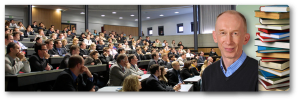 Those of us working in higher education at the moment must recognise that some of the targets to which are business schools work are leading to dysfunctional outcomes, for example staff being taken away from front line teaching and student support duties so that they can write articles for obscure academic journals.
Those of us working in higher education at the moment must recognise that some of the targets to which are business schools work are leading to dysfunctional outcomes, for example staff being taken away from front line teaching and student support duties so that they can write articles for obscure academic journals.
AACSB Associate Deans Conference: Leading in Challenging Economic Times by Karyl B. Leggio
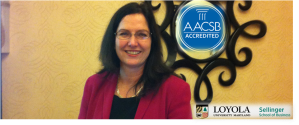 At the AACSB Associate Deans conference, Karyl Leggio, Dean and Professor of Finance at the Sellinger School of Business at Loyola University Maryland, led a fascinating discussion on the issues in setting up new programs. The topic of the presentation was centered around generating revenues and “managing costs by benefitting from revenue sharing initiatives.” Given that we are now into the fifth year of the financial crisis with no easy end in sight, this is an important subject to address.
At the AACSB Associate Deans conference, Karyl Leggio, Dean and Professor of Finance at the Sellinger School of Business at Loyola University Maryland, led a fascinating discussion on the issues in setting up new programs. The topic of the presentation was centered around generating revenues and “managing costs by benefitting from revenue sharing initiatives.” Given that we are now into the fifth year of the financial crisis with no easy end in sight, this is an important subject to address.
AACSB Annual Meeting (ICAM 2013): 5 Essential Social Media Practices for Academic Leaders (Dr. Michael Williams, Pepperdine University)
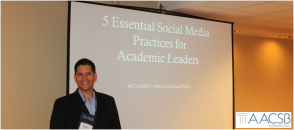 At the AACSB Annual Conference in Chicago, Dr. Michael Williams from Pepperdine University gave an excellent, practical talk on some of the strategies we can adopt for using different social media efficiently in our jobs. Dr. Williams recognizes that “we are all trapped in a high flow information world” and struggling to cope with all the different media forms that exist. The meeting was organized by the Associate Deans Affinity Group and was attended by 70 delegates.
At the AACSB Annual Conference in Chicago, Dr. Michael Williams from Pepperdine University gave an excellent, practical talk on some of the strategies we can adopt for using different social media efficiently in our jobs. Dr. Williams recognizes that “we are all trapped in a high flow information world” and struggling to cope with all the different media forms that exist. The meeting was organized by the Associate Deans Affinity Group and was attended by 70 delegates.
AACSB Annual Meeting (ICAM 2013): Building Your School’s Brand Through Executive Education
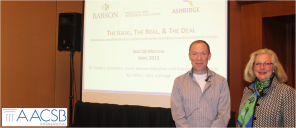 At the AACSB ICAM 2013 Conference, Elaine Eisenman, Dean of Babson College, and Kai Peters, Chief Executive of Ashridge Business School, set out some of the main issues in executive education today. Peters described the period as being one of the “most Schumpeterian times for executive education” and business schools in general. The presentation entitled “The Ideal, the Real, and the Deal” first dealt with some of the key misconceptions concerning education.
At the AACSB ICAM 2013 Conference, Elaine Eisenman, Dean of Babson College, and Kai Peters, Chief Executive of Ashridge Business School, set out some of the main issues in executive education today. Peters described the period as being one of the “most Schumpeterian times for executive education” and business schools in general. The presentation entitled “The Ideal, the Real, and the Deal” first dealt with some of the key misconceptions concerning education.
AACSB Associate Deans Conference 2012: The Many Faces of the Associate Dean
 At the AACSB Associate Deans Conference 2012, Dawn Hukai, Associate Dean at the University of Wisconsin-River Falls, Susan Laurenson, Associate Dean at The University of Auckland Business School and David J. Urban, Executive Associate Dean, at Virginia Commonwealth University discuss the many roles of an Associate Dean.
At the AACSB Associate Deans Conference 2012, Dawn Hukai, Associate Dean at the University of Wisconsin-River Falls, Susan Laurenson, Associate Dean at The University of Auckland Business School and David J. Urban, Executive Associate Dean, at Virginia Commonwealth University discuss the many roles of an Associate Dean.
If Only, The Two Saddest Words In The World
Crazy Train to Tinky Town: “I am sat here at my usual morning çay spot with my laptop and all of you for company as I do most days. The weather although hot is cooler than it has been. There are few tourists and most of the beachfront bars and restaurants are closed. The aquamarine of the Aegean still sparkles but the beaches and hotels are deserted.”







